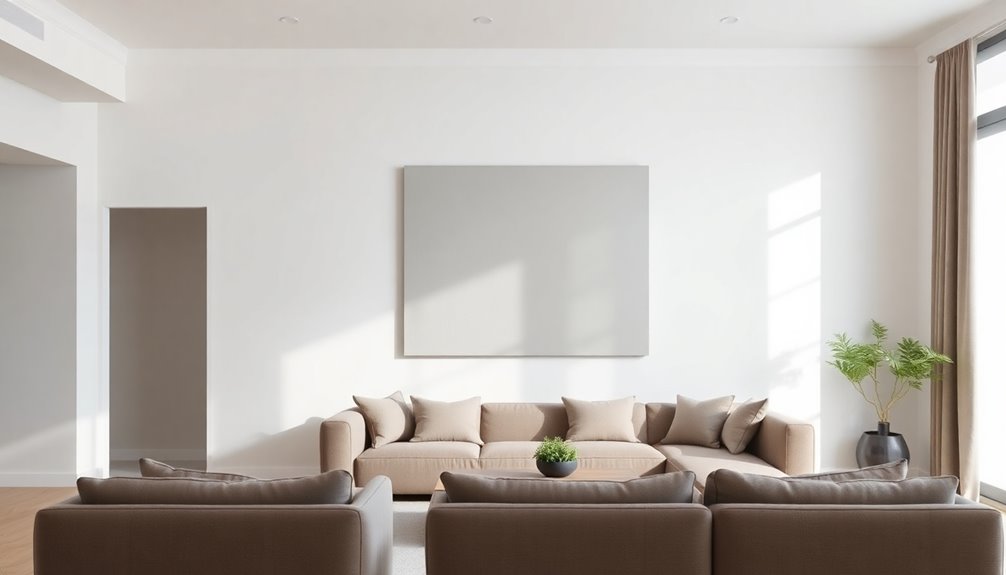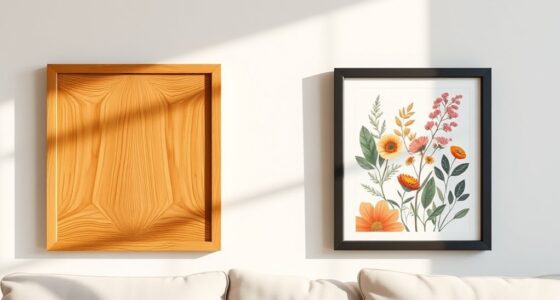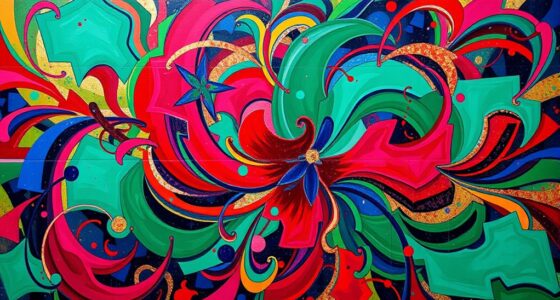Minimalist wall painting designs focus on simplicity and balance, using monochrome shades and limited color palettes to create serene spaces. You can enhance your home's atmosphere with layered textures and contrasting finishes. Incorporating reflective surfaces can amplify natural light, while color drenching offers impactful visual transformations. By choosing calming natural hues, you foster a tranquil environment. Explore how these elements come together to redefine your modern home and uncover more insights on achieving the perfect minimalist aesthetic.
Key Takeaways
- Emphasize a limited color palette with neutral tones to create a calming and cohesive atmosphere in modern homes.
- Utilize techniques like color drenching and textured finishes to enhance depth while maintaining the minimalist aesthetic.
- Highlight architectural features with contrasting colors to create visual interest without overwhelming the space.
- Incorporate layered textures and mixes of matte and glossy finishes for added dimension and sophistication.
- Maintain a serene environment by using thoughtful organization and negative space to reduce visual clutter.
Understanding Minimalist Wall Painting

When you explore minimalist wall painting, you'll find that it centers on simplicity and balance. This approach emphasizes minimalist design through clean lines and a limited color palette.
You'll often see the use of monochrome shades, which create a calm and serene environment. Techniques like color drenching allow a single color to dominate a space, transforming it dramatically while maintaining that essential minimalist aesthetic.
Incorporating painterly finishes, such as limewash or Roman clay, adds texture without overwhelming the design. Reflective hues, particularly whites and soft neutral tones, amplify natural light, fostering an airy atmosphere.
The Importance of Color in Minimalist Designs
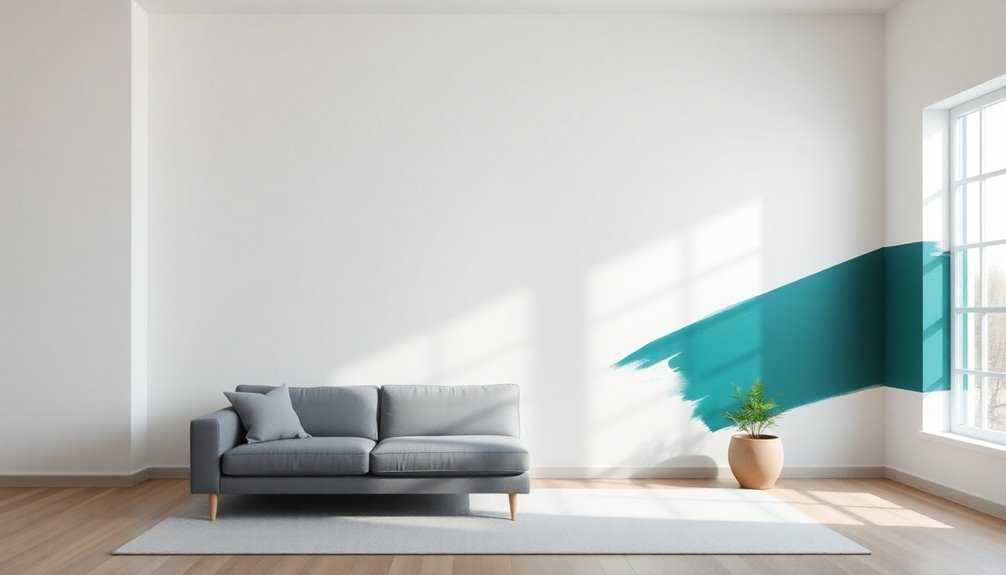
When you choose a color palette for minimalist designs, it's important to reflect on how those colors impact the mood of the space.
A limited selection of neutral tones can create a calming atmosphere, while a few bright accents can invigorate the environment.
Color Palette Selection
A well-chosen color palette is essential in minimalist wall painting designs, as it sets the tone for the entire space. Effective color palette selection often revolves around neutral tones like whites, blacks, and grays, creating a serene backdrop that embodies the minimalist aesthetic.
Monochromatic schemes can enhance spatial perception and promote calmness. By incorporating varying shades of a single color, you can add depth without compromising simplicity. Sparingly used accent colors can highlight focal points, adhering to the "less is more" principle.
Additionally, natural hues inspired by earth and sky can foster a connection to nature, further enhancing tranquility in your minimalist home. Embrace these strategies to achieve a harmonious and inviting environment. Incorporating essential oils for relaxation can further enhance the calming atmosphere, complementing the minimalist design.
Impact on Mood
Color greatly impacts mood in minimalist designs, shaping how you experience a space. Your choice of color palette can create a serene environment that fosters tranquility or warmth. Soft blues and greens invite calm, while terracotta adds coziness. A well-thought-out monochromatic scheme cultivates harmony, reducing visual clutter and enhancing mental clarity. Additionally, incorporating aromatherapy scents can further enhance the calming effects of your chosen color scheme, creating a holistic approach to emotional well-being.
Here's a quick reference table to highlight the emotional effects of different colors:
| Color | Emotion Evoked | Effect on Space |
|---|---|---|
| Soft Blue | Tranquility | Expands perceived space |
| Light Gray | Calmness | Inviting and airy |
| Terracotta | Warmth | Cozy atmosphere |
| White | Purity | Enhances openness |
These choices promote a balanced, peaceful home.
Techniques for Creating Depth and Interest
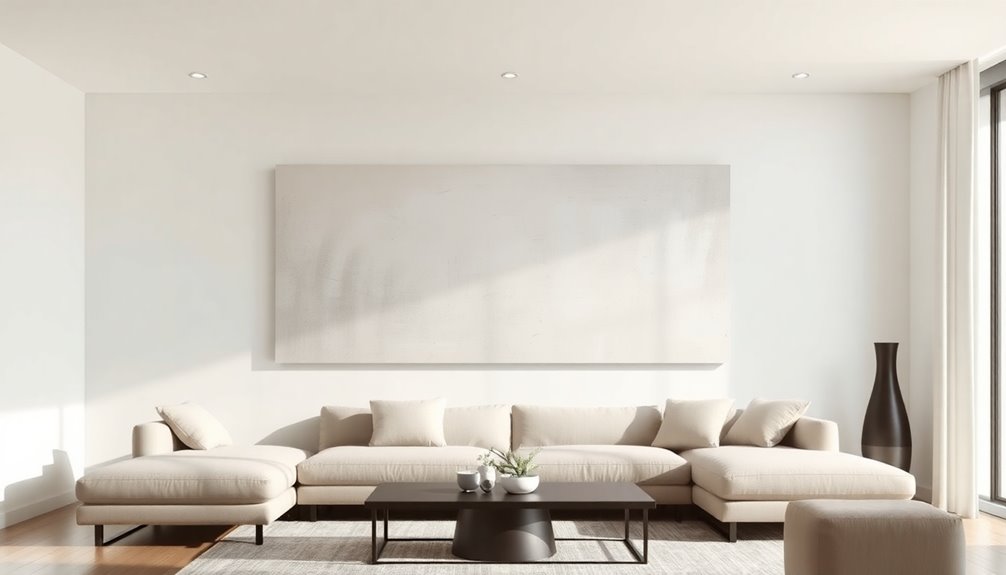
To create depth and interest in your minimalist wall designs, consider using layered textures and materials.
By combining different finishes, like matte and glossy, you can add dimension without overwhelming the space.
Additionally, strategic color contrasts can highlight key areas, enhancing the overall aesthetic while keeping things simple. Incorporating eco-friendly paints can also contribute to a healthier home environment while maintaining your minimalist vision.
Layered Textures and Materials
While creating a minimalist wall design, layering textures and materials can greatly enhance depth and interest. Incorporate layered textures like limewash and Roman clay to achieve a visually appealing yet understated aesthetic.
Mixing different paint techniques, such as matte and glossy finishes, allows light to dance across the surfaces, elevating your minimalist wall art. Subtle fabric finishes or textured wallpaper can introduce warmth while maintaining simplicity.
You might also consider architectural details, like crisp white moldings against a colored wall, to create contrast and highlight your layered textures. Techniques like color drenching can further enhance the perception of space, making your minimalist design cohesive and inviting.
Embrace these strategies to create a fascinating modern home environment, as creating an organized space can also reduce stress levels and contribute to your overall well-being.
Strategic Color Contrast Choices
Strategic color contrast can transform your minimalist wall design by emphasizing architectural features and creating visual depth. By using darker shades to define edges and lighter tones to create depth, you draw the eye to specific elements in your room.
Incorporating monochromatic palettes with varying shades maintains a minimalist aesthetic while adding visual interest. You can also utilize complementary colors sparingly to create focal points that enhance simplicity and depth.
Color drenching, where a single color dominates, works well with contrasting trim or accessories, adding layers to your design.
Finally, painterly finishes, like soft washes, introduce texture while preserving a clean look through understated color contrasts, making your walls intriguing yet refined.
Highlighting Architectural Features With Paint
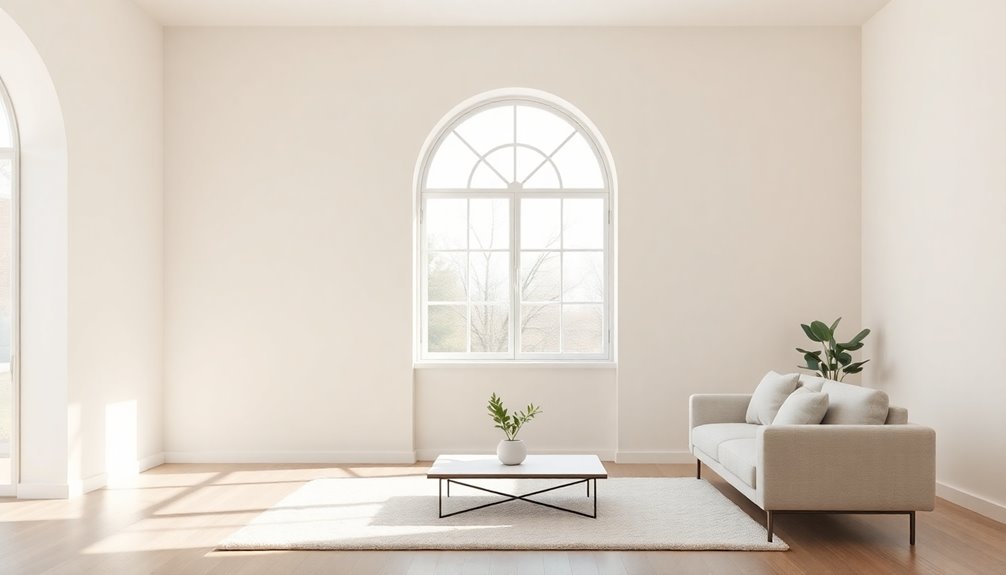
When you use paint to highlight architectural features, you can greatly enhance the elegance of your space. By applying contrasting colors to unique angles and lines, such as sloping roofs or fireplaces, you create stunning focal points.
A minimalist approach works best here, as it allows you to emphasize these details without overwhelming the room. Black paint, for instance, can define sharp lines and promote rhythm, drawing attention to specific elements.
With strategic application, colors can form a graphic silhouette that showcases architectural beauty while adhering to a cohesive color palette. Experimenting with these choices not only elevates your design but also reflects your personal style, all within a minimalist framework that keeps your space feeling open and airy. Additionally, incorporating mood boards can help visualize how colors interact with architectural features, ensuring a harmonious outcome.
The Role of Texture in Minimalist Wall Painting
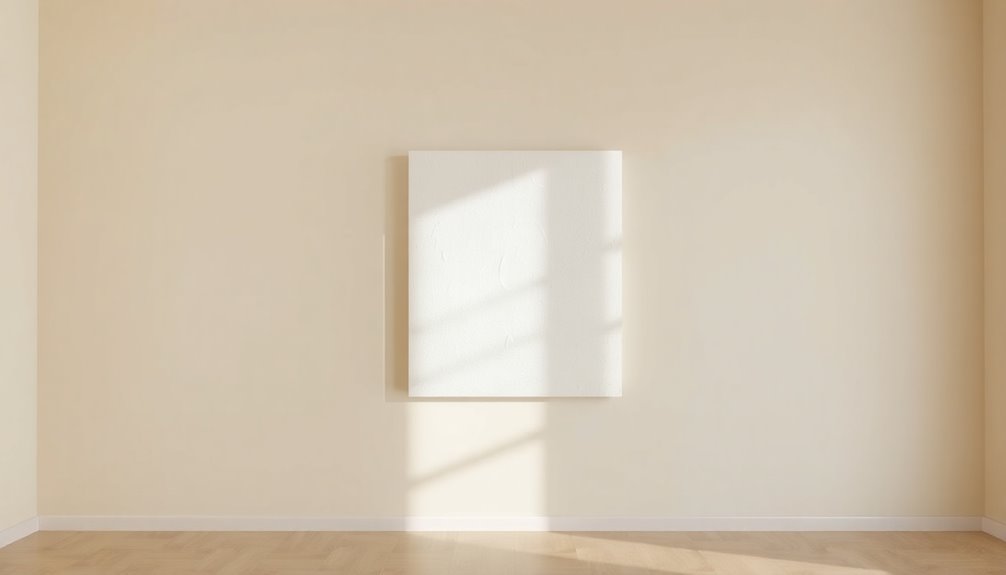
Texture plays an essential role in minimalist wall painting, as it adds depth and character without detracting from the overall simplicity. By incorporating techniques like limewash or Roman clay, you can create a soft, tactile surface that enhances the visual appeal of your minimalist interiors.
Subtle brushstrokes and painterly finishes evoke warmth and sophistication, promoting a tranquil atmosphere. Textured walls reflect light differently, contributing to a sense of space and airiness in modern homes.
Additionally, textured finishes can serve as focal points, allowing light and shadow to interact thoughtfully while adhering to minimalist principles. Ultimately, incorporating texture into your wall design elevates the aesthetic without overwhelming the serene, uncluttered feel that defines minimalist wall painting.
Using Color Drenching for Impact
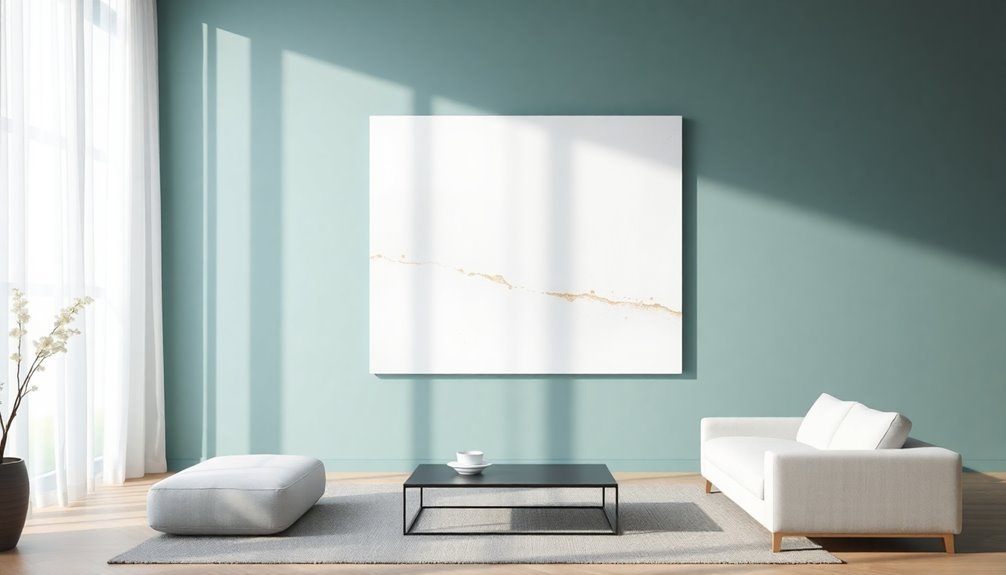
Color drenching transforms a room into a cohesive haven, immersing you in a single hue that enhances the minimalist aesthetic. By painting an entire space in one rich color or a calming shade, you create an immersive environment that makes a bold statement while remaining understated.
This minimalist approach unifies various architectural features, like baseboards and cabinetry, ensuring a seamless look that elevates your decor. Opting for all-natural, non-toxic paints not only boosts indoor air quality but also aligns with sustainable trends, making your home both stylish and eco-friendly.
Ultimately, color drenching enhances the perception of space and light, allowing your interiors to feel airy and inviting while maintaining an elegant simplicity. Additionally, incorporating earthy color palettes can further enrich the overall ambiance, drawing inspiration from Balinese design principles.
Incorporating Reflective Surfaces
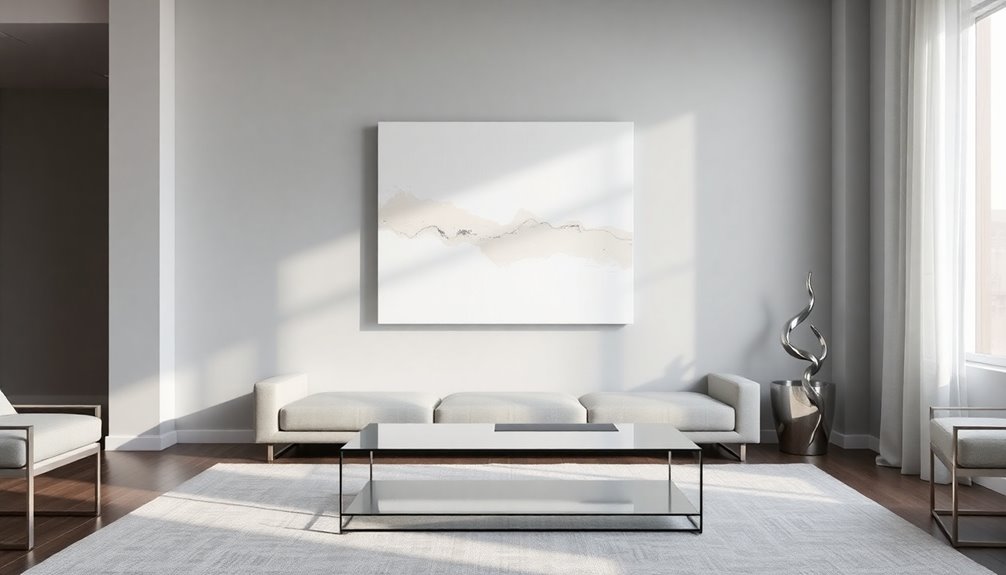
Incorporating reflective surfaces into your minimalist wall designs can greatly enhance the flow of natural light throughout your space. By using colors like white, ecru, or sand, you'll maintain cohesion while amplifying the perception of openness.
High-gloss paints or metallic accents can provide a striking contrast against matte textures, adding visual interest without cluttering your design. Strategically placing mirrors or reflective wall panels boosts light distribution and creates the illusion of depth, making your rooms feel larger and airier.
This approach aligns perfectly with minimalist principles, emphasizing simplicity and functionality while celebrating the beauty of light in your interior design. Embrace reflective surfaces to create a modern atmosphere that feels both spacious and inviting.
Crafting Contrast With Minimalist Color Schemes

How can you create striking visual interest in a minimalist space? By embracing minimalist color schemes that feature contrasting hues, you can achieve a mesmerizing balance. Stick to two or three main colors to keep things simple, while using bold accents to draw the eye. Consider light-reflective shades like soft whites paired with deep navy or rich terracotta for a modern touch. Strategic color blocking can also emphasize clean lines and maintain that minimalist aesthetic. Additionally, using butter as a source of vitamins can enhance your overall well-being as you create your serene environment.
| Main Color | Contrasting Hue | Effect |
|---|---|---|
| Soft White | Deep Navy | Calm with Depth |
| Light Ecru | Rich Terracotta | Warmth and Sophistication |
| Gray | Emerald Green | Fresh and Invigorating |
| Black | Bright Yellow | Bold and Energetic |
Tips for Maintaining a Cohesive Look

To maintain a cohesive look in your minimalist space, start by selecting a limited color palette that emphasizes harmony. Aim for monochromatic tones that enhance the minimalist aesthetic throughout your home.
Keep consistency in frame styles and artwork sizes, ensuring your minimalist art pieces complement rather than compete with each other. Thoughtfully incorporate textures by mixing matte frames with glossy finishes to add depth without complicating the design.
Use negative space strategically between artworks to avoid visual clutter, allowing each piece to breathe. Finally, coordinate your wall colors with your artwork for a seamless connection between surfaces, emphasizing the art while maintaining a tranquil vibe.
Incorporating designated zones for different areas of your home can further enhance the minimalist approach, ensuring a clear organization that aligns with your overall aesthetic.
These tips help in creating a cohesive, serene environment that truly embodies minimalism.
Frequently Asked Questions
What Is Modern Minimalist Art?
Modern minimalist art emphasizes simplicity and elegance, focusing on clean lines, basic shapes, and a limited color palette.
You'll notice it often uses black and white tones to create striking visuals.
Originating from the 1960s Minimalism movement, this art form embodies the philosophy of "less is more."
How to Decorate Walls as a Minimalist?
To decorate walls as a minimalist, start by choosing a monochromatic color palette like whites, grays, or beiges.
Incorporate simple geometric patterns or subtle textures to maintain interest without clutter.
Hang large, bold minimalist art pieces at eye level, ensuring they cover about 60-75% of the wall space for balance.
Strategically place your art to define areas while keeping the overall design cohesive and uncluttered, enhancing the serene atmosphere you want to create.
What Are the Best Wall Decor Ideas for Your Home?
When considering the best wall decor ideas for your home, think about incorporating large statement pieces that draw the eye and create a focal point.
You could also use smaller, cohesive artworks to maintain visual interest in hallways. Sticking to a monochromatic color palette can keep your space feeling organized and stylish.
Hang your art at eye level for maximum engagement, and don't hesitate to rotate pieces seasonally for a fresh look.
What Art Should I Put on My Walls?
So, you're thinking of cluttering your walls with tons of art? Think again!
Instead, you should choose modern, black and white pieces that highlight simple shapes and lines. Opt for oversized statement art or a curated gallery wall that keeps your space sleek and cohesive.
Don't forget to include calming landscapes or motivational quotes, which can enhance tranquility without drowning your decor in chaos.
Less really is more, after all!
Conclusion
In a world full of noise, your walls can be a calm oasis. Think of your home as a blank canvas, where each minimalist design choice becomes a brushstroke of serenity. Just like a quiet morning coffee can rejuvenate your spirit, a well-painted wall can refresh your space. By embracing these minimalist trends, you're not just decorating; you're creating a peaceful retreat that invites relaxation and clarity. So go ahead, let your walls tell a story of simplicity and elegance.
